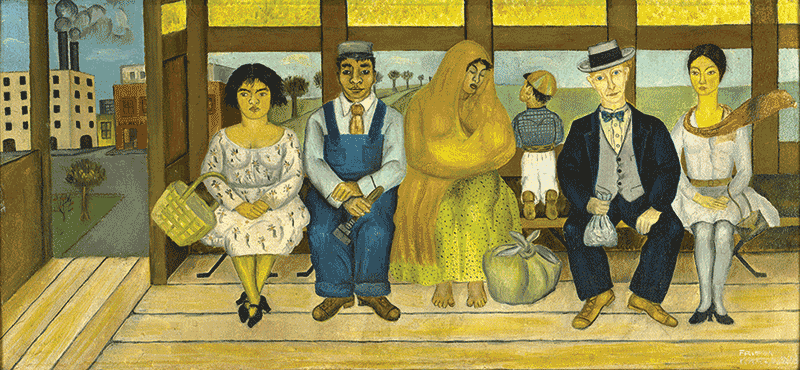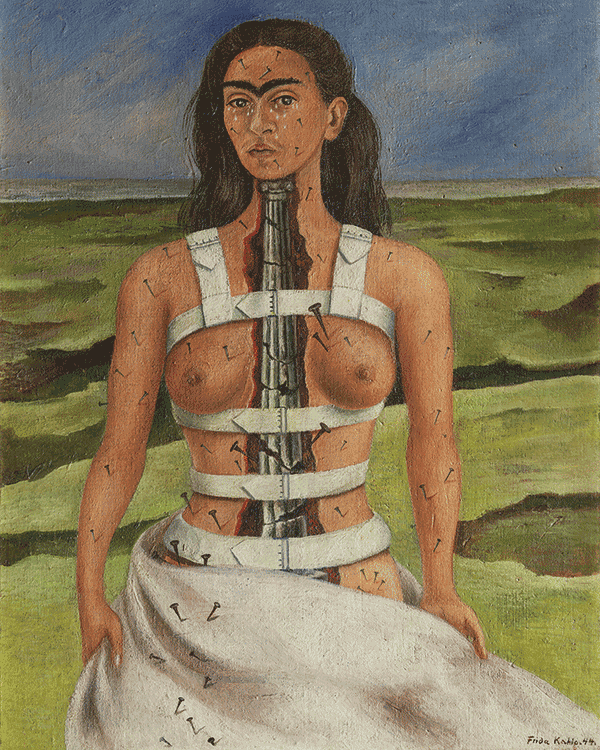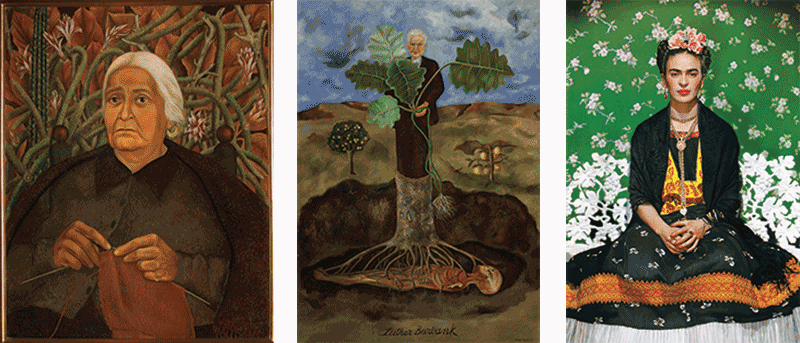Frida Kahlo: Timeless, at the Cleve Carney Museum of Art. A Transformative Exhibition for the Glen Ellyn Community


BY ALISON REILLY
In March of 2020, Justin Witte, curator of the Cleve Carney Museum of Art at the College of DuPage in Glen Ellyn, was working tirelessly with his staff to prepare for the opening of an expansive exhibition featuring the renowned artist, Frida Kahlo. In order to accommodate the 26 works of art that were scheduled to arrive, the college expanded the gallery from a 1,850 square foot exhibition space focused primarily on showing contemporary artists to a 2,500 square foot museum equipped with state of the art lighting, security, and climate control systems.
“While the administration of the college was closely monitoring the coronavirus situation, in the museum, we were very focused on our exhibition. The week of March 10th, we were busy with installation plans, working out final aspects of delivery and really moving towards the exhibition,” Witte recalls. “Because we had come so far with the exhibition, our immediate thought was, ‘How do we operate with less access to campus for what we hoped would be a short period of time?’ We had the idea that we may have to pause some of our in-person preparations for a week or two. At worst, a month.”

Witte had been working on preparations for the Kahlo exhibition with Diana Martinez, director of the McAninch Arts Center (where the museum is located) since 2017.
Alan Peterson, a longtime supporter of the college and the art center, was a close friend of Carlos Phillips, the director of the Museo Dolores Olmedo in Mexico City and son of the collector Dolores Olmedo. “Alan always had the idea that he wanted to bring the collection to the College of DuPage to help bring awareness to all the amazing cultural things happening here,” Witte explained.
While Peterson made the introduction, Witte and Martinez developed a proposal for the exhibition and outlined how it could deeply benefit the local community. “Frida was the people’s artist,” Martinez said, “To bring this to a community college with accessibility to students would have been something Frida loved, because she was a teacher herself.” Witte said that even later in her life, when Kahlo was no longer able to teach at school, her students visited her at her home, La Casa Azul, in Mexico City. “Her students were fiercely dedicated to her, and she offered them a lot.”
Inspired by Kahlo’s own example, Witte and Martinez worked with faculty to integrate themes from the artist’s life into the college curriculum. Departments offered classes on Mexican art history, the impact of the Mexican Revolution, and the social and economic context of post-revolutionary Mexico. The fashion department organized projects related to Kahlo’s wardrobe that addressed ideas of self-identity and disability, while the culinary school delved deeply into Mexican gastronomy.
“As a community college, we have an incredibly diverse population of students from young to old, from a variety of social and economic backgrounds,” Witte said. “DuPage County is an enormous area of land that covers a lot of different areas. The college serves a lot of communities. That idea of wanting to provide accessible education to such a wide range of people very much aligns with Frida’s beliefs.”
Kahlo was developing as an artist at a time in Mexico City when the scene was dominated by “Los tres grandes”—the three big Mexican muralists (Diego Rivera, David Alfaro Siqueiros, and José Clemente Orozco)—whose goal was to make work for the people. “Not squirreled away for the elites but very much for a broad population,” Witte said. “Those are also strong ideals of a community college. I think that nothing would have made Frida happier than the idea that her work would be serving as such a pivotal point in the education of the students at this college.”
When it became apparent to Witte and Martinez that the exhibition could not take place during the summer of 2020, they quickly responded by reaching out to their partners at the college and Museo Olmedo to see if it could be rescheduled for the following summer. “It was never on the table,” Witte said, “maybe in the back of our minds as fears, but it was never discussed by the college or the art center or museum that we would not be doing this exhibit—it was just the focus of when. The commitment of everyone involved never really allowed for the idea that it wouldn’t happen.”
Fortunately, with the rollout of COVID-19 vaccines across the United States and the support of the College of DuPage and the Museo Olmedo, Witte and Martinez are confident that the exhibition will open this summer on June 5, 2021. Not only have the staff at the museum and the art center worked diligently to move the programming online, many museums in Chicago and throughout Illinois have been able to reopen safely using proper protocols and social distancing. Additionally, Cleve Carney Museum of Art has created a virtual tour so that those who are not able to visit the exhibition in person will still be able to participate.
“It’s made us more creative and connected in new ways,” Martinez said. “We hosted a virtual gala where over 460 people tuned in. I think if it had been a regular gala, everyone would have been sitting at their tables, just eating. But we were able to really share information. We had the Consulate General of Mexico speak, and we gave a tour of Frida’s house in Mexico City.”
While the museum and the art center at College of DuPage have demonstrated great skill and agility in adapting to the virtual environment, for Witte, who trained as an artist, there is still no substitute for being in a room with Kahlo’s paintings. “I understand how much time is put into each work and how the decisions of the artist are recorded on the surface of the painting in every brushstroke,” he explained. “When you go to see a painting, you’re really spending time in front of something that the artist themselves spent so much time in. The way the paint dries, it captures literally whatever happens to be in the air of the studio at the time—the dust, her cigarette smoke. The opportunity to stand in front of it is the closest we can get to spending time with the artist herself.”
The expansion of the space at Cleve Carney Museum of Art will allow visitors to see 19 oil paintings and seven drawings by Kahlo, which is notably the largest exhibition of her work shown in the Chicago area in over 40 years. The paintings and drawings come from the collection of Dolores Olmedo, which was originally owned by one of Kahlo’s major patrons, Eduardo Safa. Visitors may recognize some of the works, iconic self-portraits such as Broken Column or Henry Ford Hospital, which have defined her career. But alongside these notable paintings are lesser known portraits from the late 1920s and early 1930s, which give incredible insight to Kahlo’s development as a painter.
“We’re doing all these amazing things for this exhibit,” Witte said, “there’s so many great aspects to it, but in the end, in those galleries, we’re really just creating a platform for Frida to tell her own story.”
In the context of the pandemic, Kahlo’s story has taken on even more relevance. As a woman who struggled with chronic pain and illness for most of her life, she confronted the fragility of health in a way that many have experienced this past year. “Even though our time shifted and so much of the world shifted,” Witte said, “we can still find something we can relate to in Frida’s life. Her strength serves as an inspiration for how to navigate this unprecedented time.”

More to See
Accompanying Frida Kahlo: Timeless this summer are several special features designed to enhance a visitor’s experience at the exhibition.
Frida in Photos
Frida Kahlo: Timeless features paintings and drawings by the Mexican artist, Frida Kahlo, which will be installed in the Cleve Carney Museum of Art, but the exhibition will extend beyond the walls of the museum to the entire McAninch Art Center, located on the campus of the College of DuPage. In a space adjacent to the galleries, photographs from Frida Kahlo and Diego Rivera’s personal collection will be on display. While visitors may be familiar with the iconic Kodachrome color portraits of Kahlo taken by Nickolas Muray, this selection of photographs will offer a more candid view into the artist’s life with husband Rivera.
The Artist’s Garden
In 1931 while in San Francisco, Frida Kahlo painted a portrait of Luther Burbank, a pioneering American botanist and horticulturist. Kahlo was impressed with Burbank’s research related to plant hybridization and memorialized him in the painting holding a philodendron. Inspired by Kahlo’s portrait and others in the Frida Kahlo: Timeless exhibition, local plant grower and distributor Ball Horticultural Company will create and install a garden located on the McAninch Art Center’s south patio near the amphitheater. The installation will showcase flowers and plants that were part of Kahlo’s own personal garden at her home, La Casa Azul, in Mexico City. Featured plants for the garden include: agave, alocasia dark star, bougainvillea, canna cannova bronze orange, old man cactus, oleander, prickly pear, pomegranate tree, and yucca.
Kahlo's Corner – Frida & Families
“Many aspects of Frida’s work and her life deal with very complex, real issues,” Justin Witte, curator at the Cleve Carney Museum of Art said, “and we thought it was important to offer some contextualization for younger visitors to get a sense of who she was.” Diana Martinez, director of the McAninch Art Center, collaborated with several partners to make a compelling and safe area for families. She befriended local author and illustrator Mike Venezia who helped interpret Kahlo’s life through the lens of a child. Venezia – a graduate of the School of the Art Institute of Chicago – has written hundreds of children’s books about artists, as part of The World’s Greatest Artists series. Venezia has also collaborated with the CCMA and the MAC to create “The Frida Kahlo Coloring Book,” for sale at the exhibition’s gift shop. Martinez also partnered with the architectural firm, Wight & Company, to design a full scale replica of La Casa Azul, Kahlo’s home in Mexico City, which visitors can explore. Martinez hopes that the model will allow visitors to understand the particular architecture of the house and the central role that the garden played in Kahlo’s life. Children’s area activities will include an animated video about Kahlo’s life and a mural activity designed by Venezia.
Two free printmaking workshops are planned for July 6 and Aug. 21, 10 a.m. -2 p.m., led by printmaking collective Instituto Gráfico de Chicago. Activities are geared for pre-K through third grade.
Frida Kahlo: Timeless is on view June 5 – September 6, 2021 from 10am-6pm Monday, Tuesday, Wednesday, Friday, Saturday and Sunday, and 10am-10pm Thursday. For more information and to purchase tickets, visit Frida2021.org
Note: On July 5 a new piece, unveiled as part of Art on theMART, will feature several of Kahlo’s most recognizable works, animated by George Berlin and projected onto the Merchandise Mart, accompanied by an orchestral score from Mexican composer Arturo Márquez.






